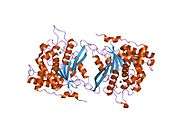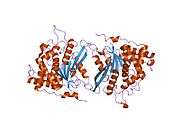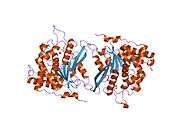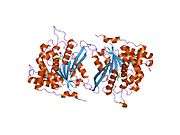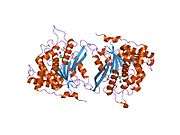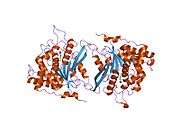QPCT
Glutaminyl-peptide cyclotransferase is an enzyme that in humans is encoded by the QPCT gene.[5][6]
This gene encodes human pituitary glutaminyl cyclase, which is responsible for the presence of pyroglutamyl residues in many neuroendocrine peptides. The amino acid sequence of this enzyme is 86% identical to that of bovine glutaminyl cyclase.[6]
References
- GRCh38: Ensembl release 89: ENSG00000115828 - Ensembl, May 2017
- GRCm38: Ensembl release 89: ENSMUSG00000024084 - Ensembl, May 2017
- "Human PubMed Reference:". National Center for Biotechnology Information, U.S. National Library of Medicine.
- "Mouse PubMed Reference:". National Center for Biotechnology Information, U.S. National Library of Medicine.
- Song I, Chuang CZ, Bateman RC Jr (Jan 1995). "Molecular cloning, sequence analysis and expression of human pituitary glutaminyl cyclase". J Mol Endocrinol. 13 (1): 77–86. doi:10.1677/jme.0.0130077. PMID 7999256.
- "Entrez Gene: QPCT glutaminyl-peptide cyclotransferase (glutaminyl cyclase)".
Further reading
- Busby WH, Quackenbush GE, Humm J, et al. (1987). "An enzyme(s) that converts glutaminyl-peptides into pyroglutamyl-peptides. Presence in pituitary, brain, adrenal medulla, and lymphocytes". J. Biol. Chem. 262 (18): 8532–6. PMID 3597387.
- Bateman RC, Temple JS, Misquitta SA, Booth RE (2001). "Evidence for essential histidines in human pituitary glutaminyl cyclase". Biochemistry. 40 (37): 11246–50. doi:10.1021/bi011177o. PMID 11551224.
- Schilling S, Hoffmann T, Rosche F, et al. (2002). "Heterologous expression and characterization of human glutaminyl cyclase: evidence for a disulfide bond with importance for catalytic activity". Biochemistry. 41 (35): 10849–57. doi:10.1021/bi0260381. PMID 12196024.
- Strausberg RL, Feingold EA, Grouse LH, et al. (2003). "Generation and initial analysis of more than 15,000 full-length human and mouse cDNA sequences". Proc. Natl. Acad. Sci. U.S.A. 99 (26): 16899–903. doi:10.1073/pnas.242603899. PMC 139241. PMID 12477932.
- Schilling S, Niestroj AJ, Rahfeld JU, et al. (2004). "Identification of human glutaminyl cyclase as a metalloenzyme. Potent inhibition by imidazole derivatives and heterocyclic chelators". J. Biol. Chem. 278 (50): 49773–9. doi:10.1074/jbc.M309077200. PMID 14522962.
- Booth RE, Misquitta SA, Bateman RC (2004). "Human pituitary glutaminyl cyclase: expression in insect cells and dye affinity purification". Protein Expr. Purif. 32 (1): 141–6. doi:10.1016/S1046-5928(03)00226-2. PMID 14680951.
- Ezura Y, Kajita M, Ishida R, et al. (2005). "Association of multiple nucleotide variations in the pituitary glutaminyl cyclase gene (QPCT) with low radial BMD in adult women". J. Bone Miner. Res. 19 (8): 1296–301. doi:10.1359/JBMR.040324. PMID 15231017.
- Gerhard DS, Wagner L, Feingold EA, et al. (2004). "The Status, Quality, and Expansion of the NIH Full-Length cDNA Project: The Mammalian Gene Collection (MGC)". Genome Res. 14 (10B): 2121–7. doi:10.1101/gr.2596504. PMC 528928. PMID 15489334.
- Huang KF, Liu YL, Cheng WJ, et al. (2005). "Crystal structures of human glutaminyl cyclase, an enzyme responsible for protein N-terminal pyroglutamate formation". Proc. Natl. Acad. Sci. U.S.A. 102 (37): 13117–22. doi:10.1073/pnas.0504184102. PMC 1201592. PMID 16135565.
- Huang QY, Kung AW (2007). "The association of common polymorphisms in the QPCT gene with bone mineral density in the Chinese population". Journal of Human Genetics. 52 (9): 757–62. doi:10.1007/s10038-007-0178-6. PMID 17687619.
This article is issued from Wikipedia. The text is licensed under Creative Commons - Attribution - Sharealike. Additional terms may apply for the media files.






